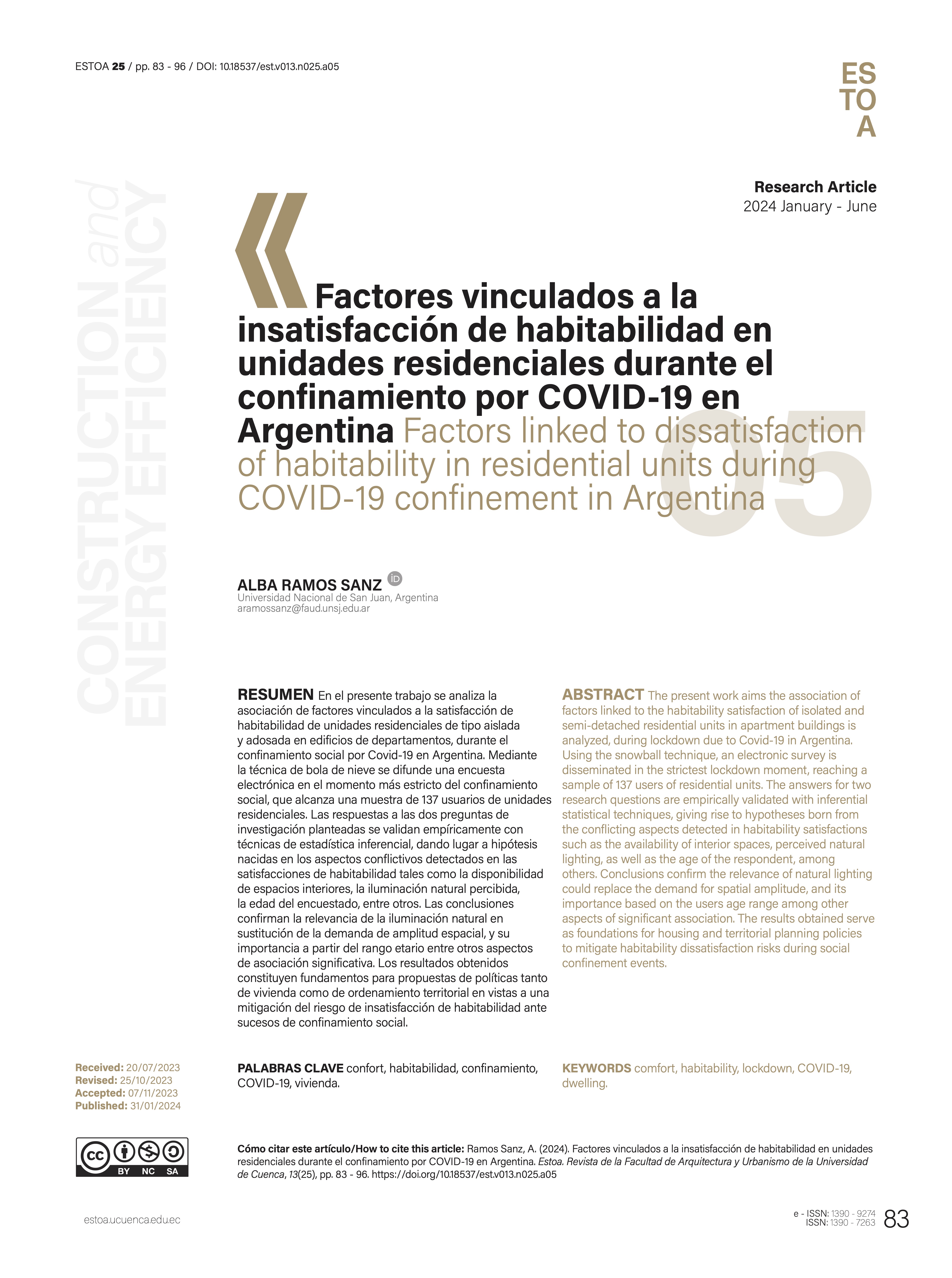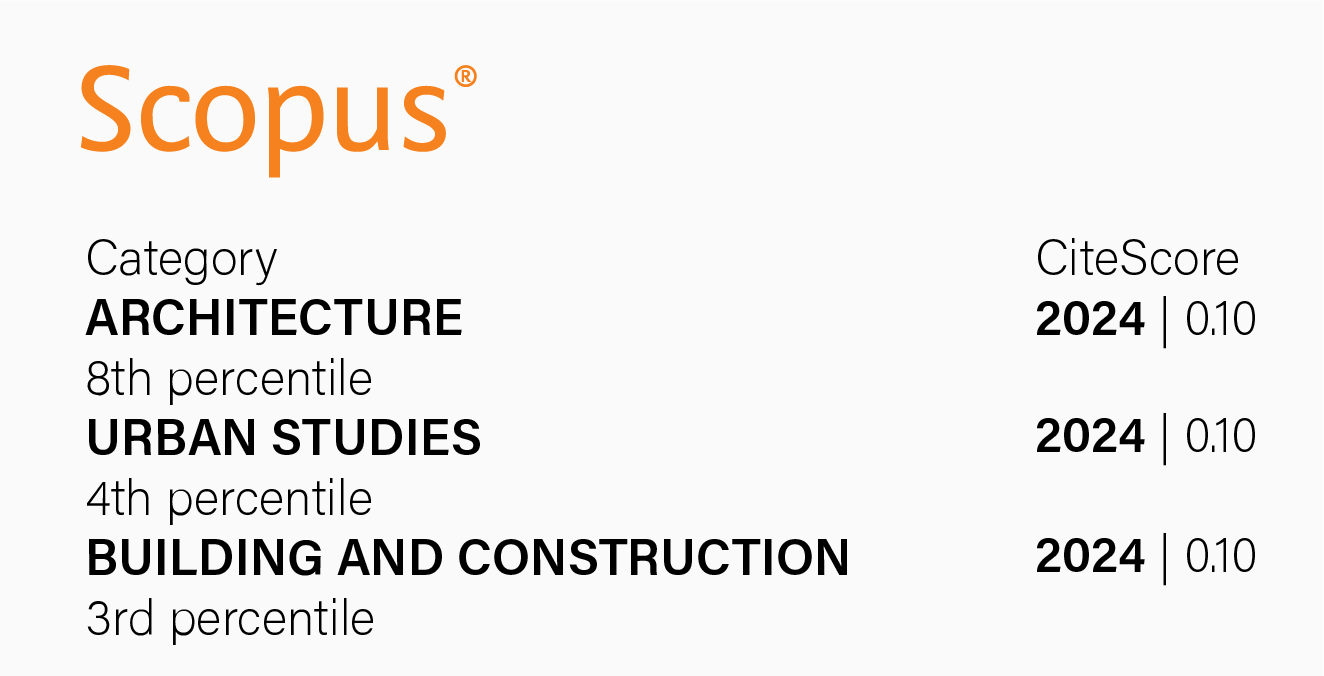Factors linked to dissatisfaction of habitability in residential units during COVID-19 confinement in Argentina
DOI:
https://doi.org/10.18537/est.v013.n025.a05Keywords:
comfort, habitability, lockdown, COVID-19, dwellingAbstract
The present work aims the association of factors linked to the habitability satisfaction of isolated and semi-detached residential units in apartment buildings is analyzed, during lockdown due to Covid-19 in Argentina. Using the snowball technique, an electronic survey is disseminated in the strictest lockdown moment, reaching a sample of 137 users of residential units. The answers for two research questions are empirically validated with inferential statistical techniques, giving rise to hypotheses born from the conflicting aspects detected in habitability satisfactions such as the availability of interior spaces, perceived natural lighting, as well as the age of the respondent, among others. Conclusions confirm the relevance of natural lighting could replace the demand for spatial amplitude, and its importance based on the users age range among other aspects of significant association. The results obtained serve as foundations for housing and territorial planning policies to mitigate habitability dissatisfaction risks during social confinement events.
Downloads
References
Alonso, M., Rubio, A., Escrig T., Soto, T., Serrano-Lanzarote, B., y Matarredona-Desantes, N. (2021). Identification of Measures to Strengthen Resilience in Homes on the Basis of Lockdown Experience during COVID-19. Sustainability, 11(13), 6168. http://doi.org/10.3390/su13116168
Córdoba, L. (17 de julio de 2019). Así serán las casas que sortea el IPV en departamentos alejados. Diario 13 San Juan. https://www.canal13sanjuan.com/san-juan/2019/7/17/asi-seran-las-casas-que-sortea-el-ipv-en-departamentos-alejados-117406.html
Cuerdo Vilches, T., Navas Martín, M., March, S., y Oteiza, I. (2021). Adequacy of telework spaces in homes during the lockdown in Madrid, according to socioeconomic factors and home features. Sustainable Cities and Society, (75), 103262. http://doi.org/10.1016/j.scs.2021.103262
D’alessandro D., Gola, M., Appolloni, L., Dettori, M., Fara, G.M., Rebecchi, A., Settimo G., y Capolongo, S. (2020). COVID-19 and Living space challenge. Well-being and Public Health recommendations for a healthy, safe, and sustai-nable housing. Acta Biomed, 91(9), 61-75. https://www.mattioli1885journals.com/index.php/actabiomedica/article/view/10115
Dirección General del Registro Oficial Nacional (2020). Aislamiento Preventivo y Obligatorio. Decreto 297/2020. Boletín Oficial de la República Argentina. https://www.boletinoficial.gob.ar/detalleAviso/primera/227042/20200320
García Ferrando, M. (1989). Socioestadística. Introducción a la estadística em sociología. Alianza Editorial.
Instituto Nacional de Estadísticas y Censos, INDEC (2020). Población. https://www.indec.gob.ar/indec/web/Nivel3-Tema-2-41
Jaimes Torres, M., Aguilera Portillo, M., Cuerdo Vilches, T., Oteiza, I., y Navas Martín, M. (2021). Habitability, Resilience, and Satisfaction in Mexican Homes to COVID-19 Pandemic. International Journal of Environmental Research and Public Health, (18), 6993. http://doi.org/10.3390/ijerph18136993
Lándazuri, A. M. y Mercado, S. J. (2004). Algunos factores físicos y psicológicos relacionados con la habitabilidad interna de la vivienda. Revista Internacional de Psicología Ambiental Medio Ambiente y Comportamiento Humano, (5), 89-113.
Lefebvre, H. (1974). La production de l’espace. Revista Sociologie de la connaissance marxisme et anthropolgie, (31-32), 15-31.
Luengo-Duque, M. H., y Rivera Crespo, O. (2022). Espacio público y pandemia: herramienta de evaluación en Santurce, Puerto Rico. Anales de Investigación en Arquitectura, 12(2), 1-15. https://doi.org/10.18861/ania.2022.12.2.3298
Malhotra, N. (2008). Investigación de Mercados. Editorial Pearson.
Organización de las Naciones Unidas (31 de octubre de 2020). La urbanización sostenible es fundamental para la recuperación económica del COVID-19. Noticias ONU. https://news.un.org/es/story/2020/10/1483362
Organización de las Naciones Unidas-Hábitat (ONU-Hábitat) (2020). Vivienda y Covid-19. ONU-Hábitat. https://onuhabitat.org.mx/index.php/vivienda-y-covid19
Organización para la Cooperación y el Desarrollo Económicos (OCDE) (2022). Affordable Housing Database. OECD. https://www.oecd.org/housing/data/affordable-housing-database/
Perleche-Ugás, D., Aiquipa-Zavala, A.M. y Tuanama-Álvarez, M. C. (2022). Condiciones de habitabilidad durante la pandemia por COVID-19: San Juan de Lurigancho, Lima-Perú. Bitácora Urbano Territorial, (32), 227-240. https://doi.org/10.15446/bitacora.v32n2.99739
Ramos Sanz, A. (2021). Satisfacción de habitabilidad durante el confinamiento por Covid-19. Estudio comparativo de dos tipologías de vivienda en Argentina. Contexto. Revista de La Facultad de Arquitectura de la Universidad Autónoma de Nuevo León, (23), 28–44. https://doi.org/10.29105/contexto15.23-281
Servicio Informativo Gobierno de San Juan (21 de agosto de 2021). El gobernador Uñac hizo entrega de 50 viviendas en el departamento de Rawson. SI/ San Juan. https://sisanjuan.gob.ar/gobernador/2021-08-02/33990-el-gobernador-unac-hizo-entrega-de-50-viviendas-en-el-departamento-de-rawson
Torres Pérez, M. E. (2021). Habitabilidad de la vivienda mínima y las ciudades en pandemia mundial: COVID-19 en Mérida, México. Revista INVI, (102), 352-383. https://doi.org/10.4067/S0718-83582021000200352
Universidad de Oxford (2022). Covid-19 Government Response Tracker (OxCGRT). Oxford University. https://covidtracker.bsg.ox.ac.uk/
Vier, S. (30 de marzo de 2018). San Juan Argentina: fundación, clima, turismo, departamentos y más. Hablemos de Argentina. https://hablemosdeargentina.com/c-provincias/san-juan-argentina/

Published
How to Cite
Issue
Section
License
Copyright (c) 2024 Estoa. Journal of the Faculty of Architecture and Urbanism

This work is licensed under a Creative Commons Attribution-NonCommercial-ShareAlike 4.0 International License.
The Journal declines any responsibility for possible conflicts derived from the authorship of the works that are published in it.
The University of Cuenca in Ecuador conserves the patrimonial rights (copyright) of the published works and will favor the reuse of the same ones, these can be: copy, use, diffuse, transmit and expose publicly.
Unless otherwise indicated, all contents of the electronic edition are distributed under a Creative Commons Attribution-NonCommercial-ShareAlike 4.0 International License.



